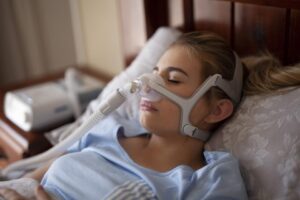A CPAP (Continuous Positive Airway Pressure) machine is designed to help people with obstructive sleep apnea (OSA) maintain continuous breathing while they sleep. When a person with OSA stops breathing, typically due to a blockage in the airway, the CPAP machine plays a crucial role.
The CPAP machine delivers a steady stream of pressurized air through a mask into the person’s airways. This air pressure acts as a splint, keeping the airways open and preventing them from collapsing, which is the common cause of breathing interruptions in sleep apnea.
When the user stops breathing, the continuous air pressure ensures that the airway remains open, allowing the person to resume normal breathing without waking up.
In essence, the CPAP machine doesn’t directly respond to a cessation of breathing by changing its function or increasing pressure. Instead, it continuously provides a set level of air pressure throughout the night, regardless of whether the user temporarily stops breathing.
This constant pressure is what prevents the airway collapse that leads to apnea events, thereby ensuring uninterrupted breathing while the user sleeps.
Table of Contents
How Does A CPAP Machine Work?
A CPAP machine works by delivering a gentle stream of pressurized air through a mask that covers your nose or mouth. The air pressure is just high enough to keep your airway open, even when your muscles relax during sleep. This prevents your breathing from stopping and starting.
Here are the steps involved in how a CPAP machine works:
- Air intake: The machine takes in room air through a filter.
- Air filtration: The air is then filtered to remove dust, pollen, and other allergens.
- Pressurization: The air is pressurized by a motor.
- Humidification (optional): Some CPAP machines have a humidifier that adds moisture to the air. This can make it more comfortable to breathe, especially if you have dry sinuses.
- Delivery: The pressurized air is delivered through a tube to a mask that fits over your nose or mouth.
There are two main types of CPAP machines:
- Standard CPAP machines: These machines deliver a constant level of air pressure.
- Auto-CPAP machines: These machines automatically adjust the air pressure based on your needs throughout the night.
CPAP therapy is the most effective treatment for sleep apnea. It can help to improve your sleep quality, reduce your daytime fatigue, and lower your risk of developing other health problems.
Signs a CPAP Machine Is Not Working
There are cases when your CPAP machine is not working properly. Here are some signs that your CPAP machine might need attention:
Physical Signs of CPAP not Working
- Snoring: If you start snoring again after using CPAP for a while, it could be a sign that the machine isn’t delivering enough pressure or that your mask is leaking.
- Daytime fatigue: Even with CPAP, you might still experience fatigue if the machine isn’t working effectively.
- Headaches: Dry mouth and headaches can be caused by breathing in dry air from a CPAP machine, which could indicate a problem with the humidifier.
- Skin irritation: If your mask is leaking, it can irritate your skin around your nose and mouth.
CPAP Machine-Related Signs
- Unusual noises: If your CPAP machine is making new or louder noises than usual, it could be a sign of a mechanical problem.
- Erratic pressure: Some CPAP machines have displays that show the air pressure level. If the pressure is fluctuating or not reaching the prescribed level, it could be a problem.
- Water leaks: If you see water leaking from your humidifier, it could be a sign of a cracked reservoir or another issue.
- Power problems: If your CPAP machine won’t turn on or if it keeps turning off unexpectedly, it could be a problem with the power cord or the machine itself.
Other signs:
- You’re not using it regularly: If you’re not using your CPAP machine every night as prescribed, it won’t be effective in treating your sleep apnea.
- You’re not feeling better: If you’re not feeling any better after using CPAP for a few weeks, it’s important to talk to your doctor. They may need to adjust your pressure settings or try a different treatment.
If you notice any of these signs, it’s important to talk to your doctor or CPAP provider. They can help you troubleshoot the problem and get your CPAP machine working properly again.
Here are some additional tips for keeping your CPAP machine working properly:
- Clean your mask and tubing regularly.
- Replace your mask and tubing every few months.
- Use distilled water in your humidifier. (Read more: Can I Use Tap Water in My CPAP?, What Happens if Your CPAP Runs out of Water, What Is CPAP Rainout and How Can I Prevent It?)
- Don’t expose your CPAP machine to extreme temperatures or humidity.
- Take your CPAP machine with you when you travel. (Find out How to Use CPAP while Camping)
By following these tips, you can help ensure that your CPAP machine is working effectively and helping you get the sleep you need.
Why Does a CPAP Machine Change Air Pressure?
A CPAP (Continuous Positive Airway Pressure) machine may change air pressure for several reasons, primarily to enhance the comfort and effectiveness of sleep apnea treatment:
Adapting to Different Sleep Stages and Positions
Your breathing can vary depending on your sleep stage and position. For instance, you might need higher pressure when sleeping on your back or during REM sleep, where sleep apnea can worsen. Some CPAP machines automatically adjust the pressure to accommodate these changes.
Exhalation Relief
Continuous high pressure can sometimes make exhaling uncomfortable. Many CPAP machines have a feature that reduces pressure during exhalation, making it easier and more comfortable to breathe out.
Auto-Adjusting Pressure (APAP)
Auto-adjusting CPAP machines, known as APAPs, continuously monitor your breathing and automatically adjust the air pressure as needed. This ensures that you receive the minimum pressure required to keep your airway open, improving comfort without compromising the effectiveness of the therapy.
User Comfort and Compliance
Adjusting the pressure, either manually by the user or automatically by the machine, can make CPAP therapy more comfortable, which is crucial for long-term compliance and effectiveness of the treatment.
Preventing Airway Collapse
In cases where the airway is prone to collapse at different levels during sleep, varying the pressure helps in keeping the airway open throughout the night.
Note that any adjustments to the CPAP machine’s settings should ideally be done under the guidance of a healthcare provider or a sleep specialist to ensure the therapy remains effective and safe.
How Does a CPAP Machine Know When Your Air Pressure Should Be Altered
A CPAP machine, particularly an Auto-CPAP (APAP) machine, knows when to alter air pressure through advanced sensors and algorithms. Here’s how it works:
- Sensors: APAP machines are equipped with sensors that continuously monitor various aspects of your breathing while you sleep. These sensors detect changes in your breathing pattern, airflow, and airway resistance.
- Detection of Breathing Irregularities: The machine’s sensors can identify signs of disrupted breathing, such as apneas (pauses in breathing), hypopneas (shallow breathing), snoring, or flow limitations (partial blockages in the airway). These disruptions can indicate that the airway is becoming obstructed.
- Algorithms: Once a potential breathing issue is detected, the machine’s built-in algorithms analyze the data. Based on this analysis, the machine determines whether an adjustment in air pressure is needed to prevent or alleviate the obstruction and maintain a clear airway.
- Automatic Pressure Adjustment: If the machine detects that the airway is narrowing or becoming obstructed, it will automatically increase the air pressure. Conversely, if the machine senses that the breathing has stabilized and the airway is open, it may reduce the pressure to enhance comfort.
- Continuous Monitoring: This process is ongoing throughout the night. The machine constantly monitors and adjusts the pressure as needed, ensuring that the user receives the optimal pressure for each stage of sleep and different sleeping positions.
This sophisticated system allows APAP machines to provide dynamic, responsive therapy that is tailored to the unique and changing needs of the user throughout the night, enhancing both the effectiveness and comfort of sleep apnea treatment.
FAQ
Can You Still Stop Breathing with CPAP?
While a CPAP machine is highly effective in preventing episodes of sleep apnea, it’s important to understand that it’s not a foolproof guarantee against stopping breathing entirely. It’s possible to experience occasional apneas or hypopneas (shallow breaths) even with CPAP. Also, if you’re not using your CPAP machine regularly or consistently, you won’t experience its full benefits, and apneas may persist.
Can You Ever Stop Using a CPAP Machine?
Whether you can ever stop using a CPAP machine depends on several factors and ultimately requires personalized advice from your doctor. If your sleep apnea is mild and caused by modifiable factors like weight gain, alcohol consumption, or certain sleep positions, addressing those factors could potentially eliminate the need for CPAP. In some cases, alternative treatments like oral appliances or surgery may be effective, allowing you to stop using CPAP.




